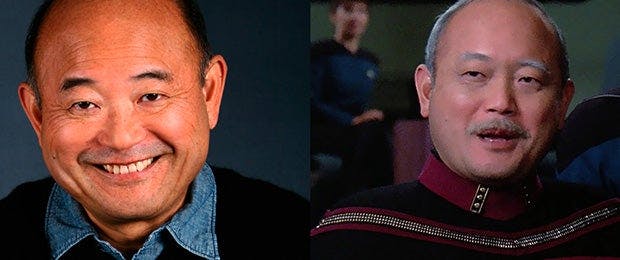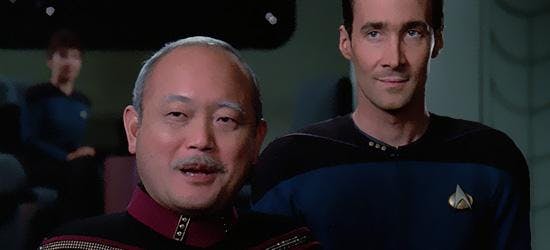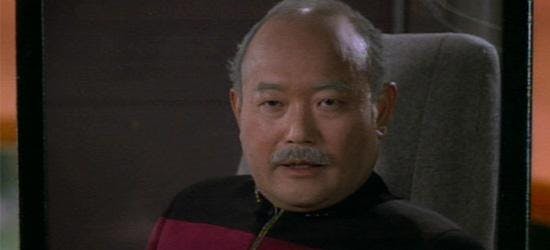Published Nov 12, 2015
INTERVIEW: Clyde Kusatsu on His Three TNG Appearances
INTERVIEW: Clyde Kusatsu on His Three TNG Appearances

What's the first role you think of when you see a picture of Clyde Kusatsu? The answer depends, perhaps, on your age and the generation you were part of when you first glimpsed the actor in action. He was, for instance, Reverend Chong on All in the Family, the English teacher in American Pie, Dr. Okamura on The Young and the Restless, Principal Shimata on Family Matters, and Mr. Lee (the father of John Cho's character) in Harold & Kumar Escape from Guantanamo Bay. And to Star Trek fans he'll forever be remembered for his recurring role as Vice Admiral Nakamura on Star Trek: The Next Generation. He appeared in three TNG episodes, "The Measure of a Man," "Phantasms" and "All Good Things..." StarTrek.com recently chatted with Kusatsu, who graciously shared memories of this Trek experiences and filled us in on what he's doing these days. Here's what he had to say...

How well did you know Star Trek before making your appearances on TNG?I was a fan of The Original Series. In the fall of '66 I was at Northwestern University and every time Star Trek appeared, everyone was glommed onto the TV set. Interestingly enough, I thought it was kind of fun to be auditioning for the admiral and then wind up being Picard's classmate and being in costume and on the bridge of the new Enterprise. It was an exciting experience, like, "Wow, this is kind of cool." I was tapping the badge right above my heart with my palm and going, "Bridge." Every actor wants to do that. And I'd wanted to do that as far back as attending Northwestern. What intrigued you most about playing the admiral, and did they tell you when you played him the first time that he'd be a recurring character?Not at the time, no. I didn't know it'd be recurring. I liked the role, though. I liked that he was a classmate of Picard's. It was exciting to me just to be guesting on a Star Trek show. I enjoyed working with the cast. I enjoyed meeting people like Michael Westmore. The show, for him, was like a lab in which to try everything and to train a whole new generation of makeup artists. He was there, I think, for TNG and all of the Star Trek shows, and so a lot of people learned their craft from him. One of the first things I ever did in this town was Kung Fu, and Frank Westmore, Michael's older brother, was the head makeup guy on that show. They were part of the old Hollywood tradition. So I was honored to be part and parcel of that. I'd previously worked with LeVar Burton. We did voiceover work for Captain Planet and the Planeteers. Whoopi (Goldberg) did it, too. Brent Spiner and I had done a pilot together called Sylvan in Paradise, with Jim Nabors. When I saw Brent on TNG, I said, "Well, this probably beats being on Sylvan," which was sort of like Gomer Pyle in Hawaii. My other Star Trek connection is that I worked with Bill Shatner a couple of times. I did an episode of T.J. Hooker and, much later, S--t My Dad Says. You ulitmately played Vice Admiral Nakamura three times. What else do you remember about the experience?I had a good time. He was an interesting character. The episodes sort of get muddled in the sands of time for me, because it was so long ago now. But what I remember was that just the whole process was so thrilling, even just to go for a wardrobe fitting. I kept going to the gym because I didn't want to have to wear a girdle or anything like that. The costumes themselves were unforgiving, if you know what I mean. Everyone was very welcoming. I couldn't believe how welcoming and open Patrick Stewart was. It was just one peer to another with him. Even just to be on the lot at Paramount was an honor. There's a lot of history there. The original Star Trek was done there. It was the old RKO, which before it became Paramount, was part of Desilu Studios. And it was Desi Arnaz and Lucille Ball, through Desilu, who green-lit Star Trek.

There'd frankly not been a lot of diversity at that point on Star Trek in terms of the nationalities of its captains and admirals. And there you were, a man of Asian descent. Even better, no one ever mentioned the character's nationality. He just was who he was...Which I loved. That was great. All that mattered in the backstory was that we were both cadets together and classmates at Starfleet Academy. I think it was more reflective of the internationalism and the worldwide spread of diversity than, say, Star Wars. It's a great universe, but everyone's either white or an alien. I think Star Wars, especially now, is improving on that, but Star Trek at the time offered better equal opportunities for a lot of actors of color to be shown. They were very open about it. I think it was a wonderful subliminal experience for the country to get used to seeing faces of different colors on their TVs. Sometimes you can affect more change by being a constant presence on that screen and not necessarily calling attention to it.How surprised were you to get the call to appear in "All Good Things...," the TNG series finale?I was very surprised, and honored to be a part of that, to be included at the very end of this seven-year journey. It's one of those little moments you put into your scrapbook, that you can look back on. At one point, someone asked me to sign 1,500 collectible Star Trek cards. I did my first Star Trek convention in August. So, even though I only did three episodes, I'm a part of this huge franchise that people love all around the world. How many people get to say they're a part of something like Star Trek? You actually auditioned to play Quark on Deep Space Nine. As far as you know, how close did you come to landing the role?My agent said, "They're wondering if you're interested in being in makeup for seven years." Like any actor who wants to work, I said, 'I'll do anything for seven years." Armin Shimerman got the role, and I don't really know how close I got. I know I was in the running because they asked me if I'd be willing to be in prosthetics for seven years.

What are you up to these days?These days I'm the president of SAG/AFTRA in Los Angeles, which is the largest local in SAG/AFTRA, and I'm also concurrently the national vice president, representing Los Angeles in the national organization. So I spend a lot of time being of service to the union itself. I find it a very rewarding kind of work. As you age, as an actor ages, the opportunities become fewer and fewer. I've been very fortunate. I'm in my 42nd or 43rd year in front of the camera, so I'm a very lucky guy to have been able to fulfill my dreams and aspirations. I started in high school, wound up as a drama student at Northwestern and then came out here and made a go of it in the film, television and animation ends of the business. I joke that the only contracts I haven't worked on in Hollywood are a singer's contract or a dancer's contract. So I'm very fortunate. And I'm still auditioning and still looking for roles.

